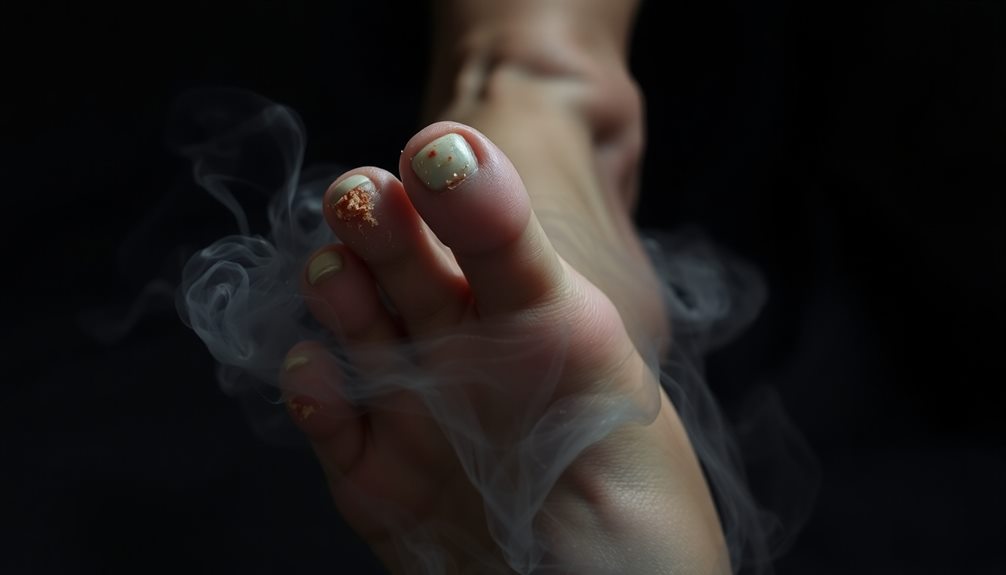Toenail fungus has a pretty distinct smell that you might find a bit off-putting. It's often described as musty or sour, similar to damp, rotting materials you'd smell in a moldy area. When you're close to the affected toenail, the odor can be even stronger. This unpleasant scent comes from fungi breaking down skin tissue and creating waste products. If you notice this smell, it might be a sign the infection is worsening, and it's important to take action. Keeping your feet clean and dry can help prevent this issue. Curious about ways to tackle toenail fungus?
Key Takeaways
- Toenail fungus typically emits a musty or sour odor, often likened to damp, rotting materials.
- The smell intensifies when in close proximity to the affected area.
- Odor arises from fungal waste products breaking down tissue and dead skin cells.
- Persistent foul smells can indicate worsening infections that require medical attention.
- Recognizing the odor is essential for prompting early intervention and treatment.
Introduction
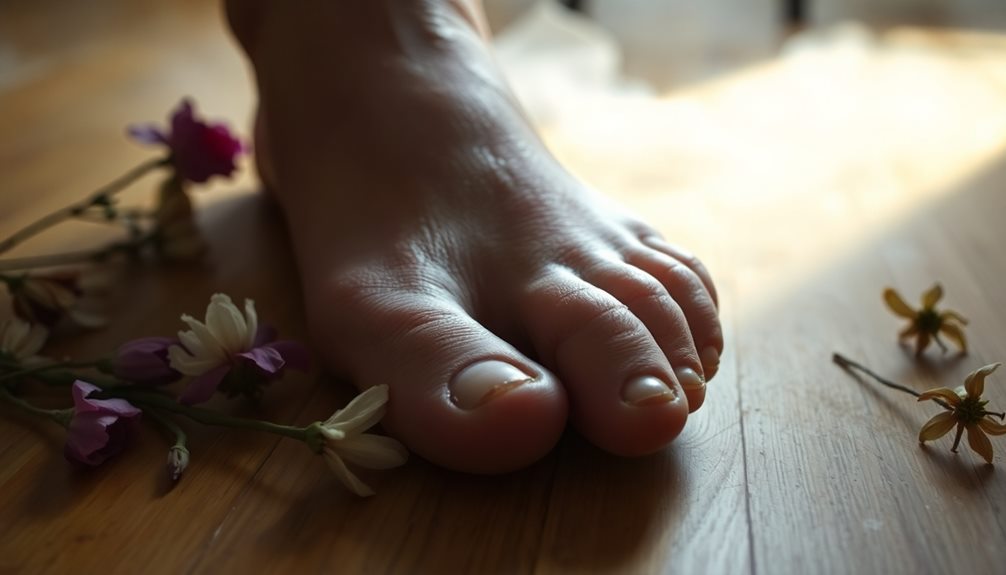
Dealing with toenail fungus can be frustrating, especially when an unpleasant smell accompanies it. You might find yourself wondering what's causing this odor and how to get rid of it. Toenail fungus is a common issue that many people face, and it can strike anyone.
When your toenails become infected, they may change in color, thickness, and even shape. As the fungus grows, it can produce a smell that's hard to ignore.
Understanding the source of this smell is essential, as it can help you tackle the problem more effectively. Fungi thrive in warm, damp environments, so if your feet sweat a lot or if you wear tight shoes, you might be more prone to this issue.
It's not just about the smell; it's also about taking care of your feet and ensuring they stay healthy.
Description of the Smell

The smell associated with toenail fungus is often described as musty or sour, resembling the odor of damp, rotting material. Imagine a forgotten corner of a basement, where moisture collects and mold starts to grow. That's a bit like the scent you might encounter with toenail fungus. It can be quite unpleasant, making you wrinkle your nose in disgust!
When you're close to the affected area, you might notice a stronger whiff that can catch you off guard. This odor isn't just a minor inconvenience; it can be a telltale sign that something's not quite right. The smell often lingers, even if you try to mask it. It's important to pay attention to this scent, as it can indicate the need for treatment.
If you ever find yourself in this situation, don't worry! Many people experience toenail fungus, and it's nothing to be ashamed of. Acknowledging the smell is the first step toward addressing the issue.
Source and Composition
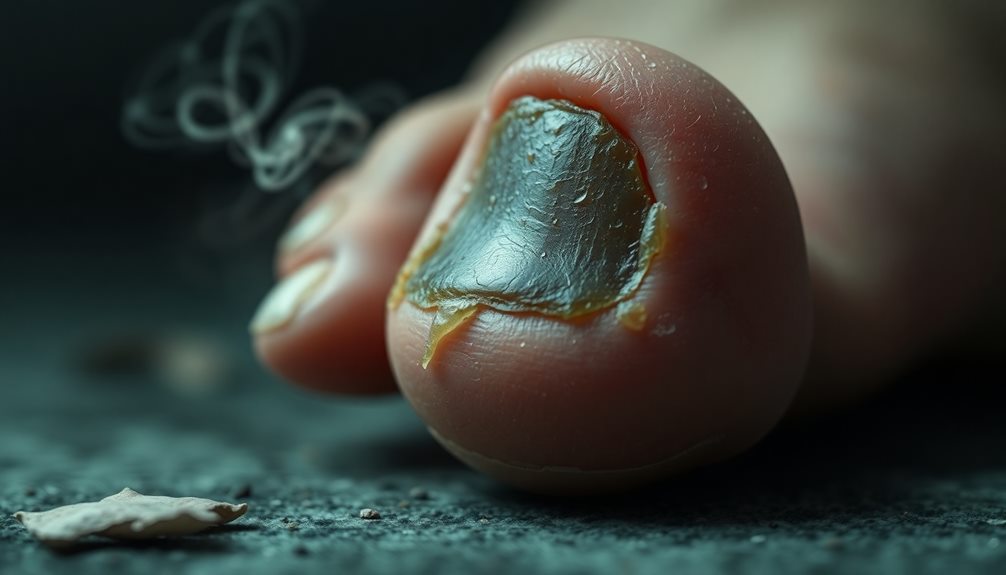
Often, toenail fungus comes from a combination of fungal infections and environmental factors. These pesky fungi love warm, damp places, so they often find their way into your nails when conditions are just right.
When you walk around barefoot in public areas, like pools or gyms, you might unknowingly pick up these tiny invaders.
The composition of toenail fungus includes various types of fungi, primarily dermatophytes, which thrive on keratin, a protein found in your nails. When these fungi feast on keratin, they can cause your nails to become discolored, thickened, and yes, even smelly!
The odor you notice usually results from the waste products the fungi produce as they break down the nail and surrounding tissue.
If you think about it, that smell isn't just the fungus; it's a mix of dead skin cells, bacteria, and the byproducts of the fungi's feast. It's like a little party gone wrong on your toes!
Understanding the source and composition of toenail fungus can help you take better care of your feet and prevent future problems. So, keep those toes clean and dry, and they'll thank you later!
Typical Scenarios or Environments

Many people encounter toenail fungus in typical environments where moisture and warmth thrive.
Picture a crowded gym locker room or a public swimming pool. These places are often steamy and humid, creating the perfect breeding ground for fungi. When you walk around barefoot on wet floors, you're at a higher risk of picking up those pesky spores.
You might also find toenail fungus lurking in your own home, especially in bathrooms where dampness hangs around.
Think about those cozy slippers you wear after a shower. If they stay damp, they can become a comfy home for fungus to grow. Even your favorite pair of shoes, if they're often worn without socks, can trap moisture and lead to toenail problems.
Walking on sandy beaches can also be tricky.
While you enjoy the sun, your feet might get wet from waves or water sports, creating an opportunity for fungi to invade.
Remember, being proactive can help you avoid these scenarios.
Keep your feet dry, wear breathable footwear, and always dry off thoroughly after swimming or showering. Taking these steps can help keep your toes happy and fungus-free!
Emotional or Cultural Associations

Toenail fungus can evoke a mix of emotions and cultural perceptions that range from embarrassment to stigma. You might feel self-conscious about the appearance of your nails, fearing judgment from others. This discomfort is understandable, as society often emphasizes looking perfect and healthy.
Culturally, some people associate toenail fungus with poor hygiene or neglect, which can deepen feelings of shame. You might even worry that others will think less of you. In many cultures, there's a strong belief in maintaining cleanliness and beauty, leading to a sense of inadequacy when faced with such a condition.
However, it's important to remember that toenail fungus can affect anyone, regardless of hygiene habits. It's a common issue that many people deal with, so you're not alone. By sharing your experience, you can help break down these stigmas and foster a sense of understanding and support.
Embracing a positive outlook and focusing on treatment options can empower you to manage the situation better. The more open you're about toenail fungus, the more you encourage others to seek help, too!
Ultimately, it's about health and well-being, not judgment.
Health or Safety Considerations
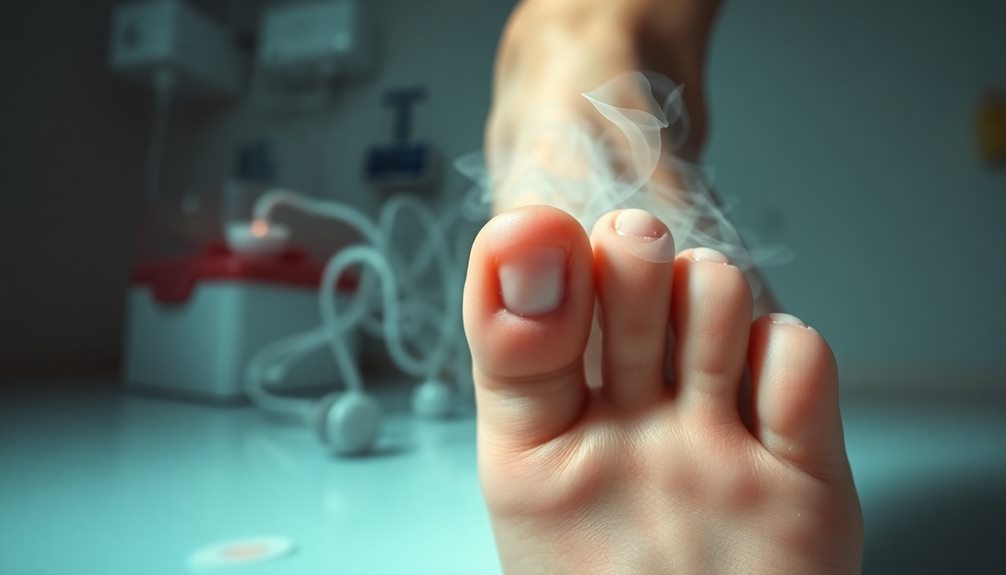
Understanding the health implications of toenail fungus is crucial for effective treatment and prevention. Toenail fungus, or onychomycosis, can lead to uncomfortable symptoms that may interfere with your daily life.
If you notice a strong, unpleasant smell coming from your toenails, it's often a sign that the infection is worsening. Ignoring these signs can allow the fungus to spread, potentially causing pain, swelling, or even more serious issues.
You might also find that the condition affects your self-esteem, making you hesitant to wear sandals or go barefoot. Taking action is important!
You should keep your feet clean and dry, as moisture encourages fungal growth. Make sure to wear breathable footwear and avoid sharing shoes or socks with others.
If you're experiencing symptoms, it's wise to consult a healthcare professional. They can prescribe effective treatments, like antifungal medications, to help you regain healthy toenails.
Final Thoughts
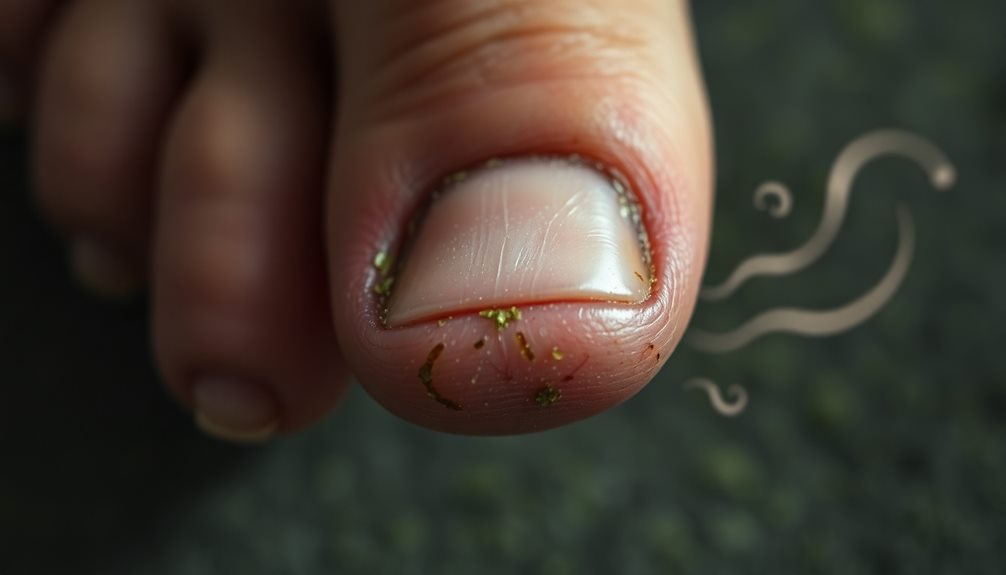
Taking care of your toenail health is a vital part of overall well-being. When toenail fungus strikes, it can bring not just discomfort but also a distinctive smell that's hard to ignore.
Understanding what toenail fungus smells like can help you identify the problem early. It often has a musty or sour odor, which might make you feel embarrassed. But remember, you're not alone—many people face this issue.
If you notice changes in your toenails, don't hesitate to take action. Keeping your feet clean and dry, wearing breathable shoes, and trimming your toenails regularly can help prevent infections.
And if you do detect that pesky fungus, consulting a healthcare professional is key to reclaiming your toenails' health.
In the end, maintaining toenail health isn't just about avoiding unpleasant smells; it's about feeling good in your skin. So, take pride in your feet!
Regular check-ups and good hygiene can keep your feet looking and feeling great. Here's to healthy toes and a confident you!
Frequently Asked Questions
Can Toenail Fungus Cause Other Health Issues?
Toenail fungus can lead to more than just unsightly nails. If left untreated, it might cause pain, spread to other areas, or even lead to bacterial infections, especially in individuals with weakened immune systems. Stay vigilant!
Is Toenail Fungus Contagious Through Shoes?
Toenail fungus can spread through direct contact, but it's unlikely to transmit through shoes. If you share footwear, you might increase your risk, so it's best to avoid sharing shoes to protect your feet.
How Long Does Toenail Fungus Typically Last?
Toenail fungus can last several months to years if untreated. You'll notice it worsening over time, so it's crucial to seek treatment early. Regular checks and proper care can help manage and reduce its duration.
What Are Natural Remedies for Toenail Fungus?
You can try tea tree oil, apple cider vinegar, or garlic. Apply these remedies consistently to help combat toenail fungus. Remember, patience is key, and consult a healthcare professional if symptoms persist or worsen.
Can Diet Affect Toenail Fungus Symptoms?
Yes, your diet can affect toenail fungus symptoms. Eating a balanced diet rich in vitamins and minerals boosts your immune system, helping your body fight off infections, including those caused by toenail fungus.
